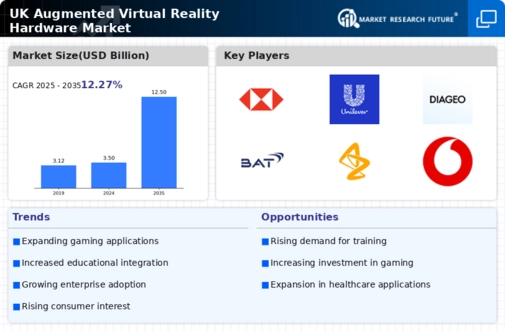Technological Advancements in Hardware
The augmented virtual-reality-hardware market is experiencing rapid technological advancements, which are driving its growth in the UK. Innovations in processing power, display technology, and sensor accuracy are enhancing user experiences. For instance, the introduction of lightweight headsets with high-resolution displays is making augmented reality more accessible. According to recent data, the market is projected to grow at a CAGR of 25% over the next five years, indicating a robust demand for advanced hardware solutions. These advancements not only improve the functionality of devices but also expand their applications across various sectors, including gaming, training, and entertainment. As hardware becomes more sophisticated, it is likely to attract a broader audience, thereby propelling the augmented virtual-reality-hardware market forward.
Growing Demand for Immersive Experiences
Consumer preferences are shifting towards immersive experiences, significantly impacting the augmented virtual-reality-hardware market. In the UK, there is a notable increase in demand for products that offer engaging and interactive environments. This trend is particularly evident in the gaming and entertainment sectors, where users seek more realistic and captivating experiences. Market data suggests that the revenue generated from immersive experiences is expected to reach £1 billion by 2026. As consumers become more accustomed to these experiences, the demand for high-quality augmented virtual-reality hardware is likely to rise. This growing appetite for immersive content is a key driver for innovation and investment in the augmented virtual-reality-hardware market.
Expansion of Retail and E-commerce Applications
The augmented virtual-reality-hardware market is witnessing an expansion in retail and e-commerce applications, which is driving its growth in the UK. Retailers are increasingly adopting augmented reality solutions to enhance customer engagement and improve the shopping experience. For example, virtual try-on solutions allow customers to visualize products before purchase, leading to higher conversion rates. Market analysis indicates that the integration of augmented reality in retail could boost sales by up to 30% in the coming years. This trend not only benefits retailers but also encourages hardware manufacturers to innovate and create devices tailored for retail applications, thereby propelling the augmented virtual-reality-hardware market.
Rising Popularity of Remote Collaboration Tools
The augmented virtual-reality-hardware market is being positively influenced by the rising popularity of remote collaboration tools. As businesses in the UK increasingly adopt virtual collaboration platforms, the demand for augmented reality hardware that facilitates these interactions is growing. This trend is particularly relevant in sectors such as architecture, engineering, and design, where visual collaboration is essential. Data suggests that the market for remote collaboration tools is expected to grow by 20% annually, driving the need for compatible augmented virtual-reality hardware. As organizations seek to enhance productivity and communication, the augmented virtual-reality-hardware market is likely to see sustained growth.
Increased Investment in Research and Development
Investment in research and development (R&D) is a crucial driver for the augmented virtual-reality-hardware market. Companies in the UK are allocating substantial resources to develop cutting-edge technologies that enhance the functionality and usability of augmented reality devices. This focus on R&D is expected to yield new products that cater to diverse consumer needs, from gaming to professional training. Recent statistics indicate that R&D spending in the tech sector has increased by 15% over the past year, reflecting a commitment to innovation. As companies strive to differentiate their offerings, the augmented virtual-reality-hardware market is likely to benefit from a continuous influx of advanced technologies and solutions.


















Leave a Comment